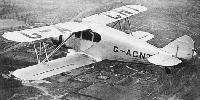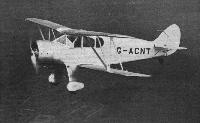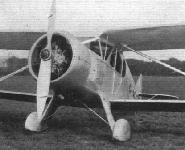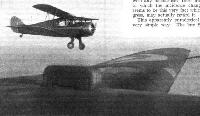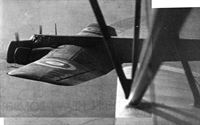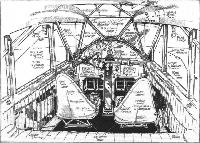
Avro 641 Commodore
В начале 1930-х годов в США начала расти популярность туристских самолетов, что подвигло фирму "Avro" на разработку модели 641 Commodore. Его предшественником был Avro 639, вариант модели Club Cadet с кабиной, построенный в единственном экземпляре в 1933 году. Самолет Commodore отличала улучшенная аэродинамика, металлическая конструкция и возможность перевозки до пяти человек, включая пилота. Прототип был передан заказчику в мае 1934 года, за ним последовали еще пять самолетов.
Однако в Великобритании тогда самолеты данного класса востребованы не были, поэтому дальнейших заказов на Commodore не поступило. Первый и второй серийные самолеты поступили на вооружение ВВС Египта, но прежде некоторое время эксплуатировались частными лицами в Великобритании. Третий и четвертый самолеты в начале Второй мировой войны были реквизированы британскими ВВС - один из них разбился в августе 1941 года в Уайт-Уолтхэме, а другой прослужил всего на год больше.
ТАКТИКО-ТЕХНИЧЕСКИЕ ХАРАКТЕРИСТИКИ
Avro 641 Commodore
Тип: 5-местный туристский самолет
Силовая установка: один звездообразный двигатель Armstrong Siddeley Lynx IVC мощностью 240 л. с. (179 кВт)
Характеристики: максимальная скорость на оптимальной высоте 209 км/ч; крейсерская скорость на оптимальной высоте 177 км/ч; скороподъемность на уровне моря 213 м/мин; практический потолок 3505 м; дальность полета 805 км
Масса: пустого 1015 кг; максимальная взлетная 1588 кг
Размеры: размах крыла 11,38 м; длина 8,31 м; высота 3,05 м; площадь крыла 28,52 м2
Описание:
- Avro 641 Commodore
- Flight, May 1934
THE AVRO "COMMODORE"
Фотографии
-
Мировая Авиация 40
Регистрационный номер: G-ACNT [7] G-ACNT - первый прототип самолета Commodore - был снят с эксплуатации в 1939 году, но утилизирован только в 1950-м.
Avro 641 Commodore. -
Flight 1934-05 / Flight
Регистрационный номер: G-ACNT [7] COMFORTABLE TRAVEL: The Avro "Commodore" ("Lynx" engine).
-
Flight 1934-05 / Flight
Регистрационный номер: G-ACNT [7] FOR COMFORT AND SOLIDITY: Spectacular performance has not been sought in the design of this Lynx-engined Avro. The machine is a 4-5 seater with dual control, and is finished and upholstered in a style comparable with that of a high-class motor car.
-
Flight 1934-05 / Flight
Регистрационный номер: G-ACNT [7] THE AVRO "COMMODORE": The undercarriage is semi-cantilever, and the wing bracing consists of a single lift wire and a single anti-lift strut.
-
Flight 1934-05 / Flight
Регистрационный номер: G-ACNT [7] THE BUSINESS END: The Siddeley "Lynx" is enclosed in a N.A.C.A. cowling. An electric starter is fitted.
-
Flight 1934-05 / Flight
Регистрационный номер: G-ACNT [7] THE AVRO "COMMODORE": Ailerons are fitted on the lower wing only, where they are readily accessible for adjustment.
-
Aeroplane Monthly 1988-01 / Personal album. Civil
Регистрационный номер: G-ACUG, DJ710 Looking more like a product of the American Waco company, this five-seat tourer was actually made by Avro. The Avro 641 Commodore was powered by a 215 h.p. Armstrong Siddeley Lynx IVC radial engine. G-ACUG was first owned by Maj J. E. Durrant Shaw, in September 1934. After impressment into the RAF in February 1941 as DJ710, the Commodore was written off following a stall while landing at White Waltham on August 10 same year.
-
Flight 1937-10 / Flight
TAKER - AND TAKEN: This snapshot was taken from an Armstrong Whitworth Whitley. In the Avro Commodore, flown by Flt. Lt. Reynell, is Flight's chief photographer, and they are just manoeuvring into position to secure the striking close-up picture.
Другие самолёты на фотографии: Armstrong Whitworth Whitley / A.W.38 - Великобритания - 1936
-
Flight 1940-03 / Flight
AT CLOSE RANGE: An Armstrong Whitworth Whitley heavy bomber photographed from a machine flying close alongside. The pilot of the Whitley was F/O. E. S. Greenwood, the assistant A.W. test pilot.
An early Whitley photographed from an Avro Commodore. There was a distinct lifting of the wing tip when it approached close to that of the Whitley.Другие самолёты на фотографии: Armstrong Whitworth Whitley / A.W.38 - Великобритания - 1936
-
Air International 1982-05 / ??? - Egypt: an air power in transition (2)
One of the two Avro 641 Commodores operated in the late 'thirties by the EAAF’s Royal Flight, one having been purchased from an Egyptian private owner and the other from Sqn Ldr V H Tait, seconded from the RAF as CO of the first EAAF squadron.
-
Flight 1934-07 / Flight
AVROS AT THE S.B.A.C. DISPLAY: From front to back, the "Cadet," the Autogiro, the "Commodore," the 626, and the 642.
Другие самолёты на фотографии: Avro Cadet / Type 631/643 - Великобритания - 1932Avro Tutor/Sea Tutor/Prefect / Type 621/646/626 - Великобритания - 1929Avro Type 642 - Великобритания - 1933Cierva/Avro C.30A / Rota - Великобритания - 1932
-
Flight 1934-05 / Flight
THE CABIN ARRANGEMENT: Plenty of room everywhere, and a good view in all essential directions are the outstanding features. The instrument board lay-out is unusual.
-
Flight 1935-01 / Flight Advertisements
Регистрационный номер: G-ACNT [7] -
Flight 1934-05 / Flight
The larger sketch shows the arrangement of the main fuselage and wing structure members, while the smaller sketches illustrate some of the details.
-
Flight 1934-05 / Flight
Avro 641 215 hp. Siddeley "Lynx" Engine
- Фотографии
